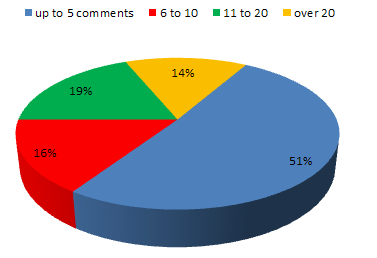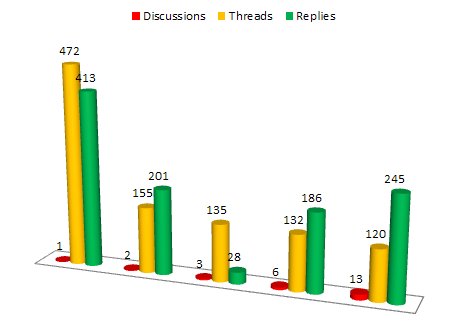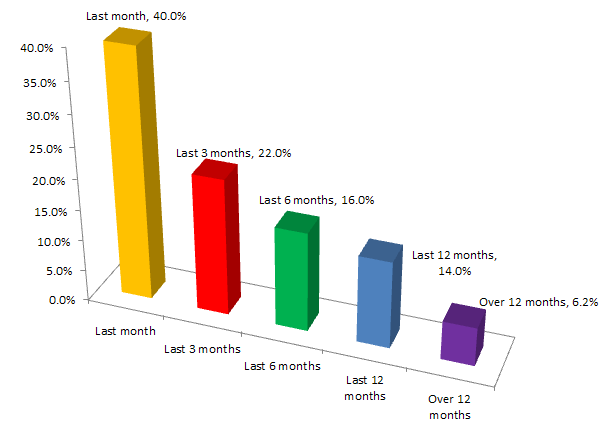How successful is your own intranet?
How is your intranet doing?
How do you know this?
Is it through your own gut feeling?
Have you sought feedback, either formal or informal from users? Or have you objective evidence as to how the intranet is doing and fulfilling its objectives?
Interact has worked with many clients and therefore has an insight into the blueprint for an effective intranet. Working with clients we have gathered together anonymous data that reveals how an intranet is used and its content and behaviour of users. Here are a few of the highlights from this torrent of intranet usage data gathered from hundreds of intranets and hundreds of thousands of users.
It’s good to talk #1. Blog
Blogging is an effective communication stream if it is not the sole preserve of top down comms, where blogs are authored by or ghost written for senior managers or directors and aimed at the masses. Evidence from Interact Intranet installs shows that less than a fifth (19%) of bloggers had job titles such as CEO, Director, Head of … , Manager or equivalent in their job title.
Of much more interest is that a huge 81% of blogs are from the “front line” or “non-managers.” This shows it is a far more effective communication stream. This allows these bloggers to share best practice, to engage, to question, to communicate, to inspire. Blogs are not a one way channel for communication, a good blog and an effective blogger will encourage two-way communication. Our analysis reveals that 19% blogs had comments made on them and it was good to see that these comments had been replied to as 14% of blog comments were made by the author themselves. The relatively low number of blog comments may highlight the need for the intranet governance to support and encourage use as it may well be that blog readers have not been previously used to such opportunities for open communication. There is anecdotal evidence from some clients that where the culture supports it comments appear against 70% of blogs with many users engaging in the discussion.
Comments made per blog
This graph shows the amount of comments made against those blogs that had comments on.
Advice from Mark Morrell on intranet governance includes recommending that the mindset of those who write governance documentation should be to have, “let everyone use…’ as the rule, and not the exception. It is pleasing to see such widespread blogging on Interact installations and although not all blogs would be promoted, as some may exist only to be read within the users profile, it is clear that where the culture supports it blogs are being used as a popular and effective communications channel.
See how one client drove intranet usage and adoption by using Interact’s blogging tool.
It’s good to talk #2 Discuss
Participation in discussion forums is another example of collaborative activity that can achieve very high levels of engagement where the culture supports it.
Taking figures from across the board then 8% of active intranet users have contributed to a thread or posting a reply. This encompasses data from intranets that feature one discussion board to intranets that feature multiple (in excess of 50) discussion boards. However a greater level of success can be achieved, where the culture supports it engagement can rise to nearly 25%. To have an intranet where a quarter of all users are active on discussion forums is a phenomenal achievement.
There is one intranet that has a single discussion board with 400+ threads with 400+ posts. It is included on the graph below along with the remaining ‘Top 5’
Top 5 by number of threads
This graph shows the top 5 by number of threads. Number of discussion boards (to left, in red) number of threads those boards host (middle, in yellow) and the number of replies to those threads (to right, in green.)
Both blogs and discussion forums are examples of informal contribution to an intranet and the opportunities and benefits of this were revealed by Wedge in an earlier blog, The only way to create a successful intranet
More than useful
If content is king then it is vital that it is relevant to its audience. An intranet that is cluttered with irrelevant content is one that has reduced efficiency. One way to gauge the relevance of content is to discover the frequency with which it is accessed. The graph below shows that nearly 2/3 of intranet content has not been viewed within the last 3 months and that 40% of content has not viewed within the last month alone. This is quite staggering as intranet content does not get there without someone taking time to add it. It could well be that the time they are spent on adding content that is not viewed could be directed towards being spent on creating and maintaining more useful content.
Having such a high proportion of unviewed content could reveal the often forgotten ‘flip-side’ of publication – that of content deletion. Our experience with hundreds of content managers is that adding content is easy and too many second nature. A less common behaviour is the active management of content and removing it when its timeliness and relevance has passed.
Content not viewed in …
The fact that content is viewed is no measure of its value to users but it is a good indicator if the intranet offers and contains the content required by users. After all a “view” might be someone accessing a page, quickly scanning through it, realising it isn’t what they wanted or expected and then exiting. This graph does not show the age of the unviewed content, it could be argued that you would be happier with aged content being unviewed rather than that content that was recently added. With regard to the content analysed above experience would suggest that it is content that has been on the intranet for 3 months or longer.
What these statistics reveal is that there is a clear case for content strategy and governance. Is the right content being added in the first place? Once it is added is it maintained, reviewed and deleted? Is content actively owned or is it just put on the intranet and left?
Evolving Intranet
Statistical analysis of the intranet, its content and the behaviour of users will reveal what is going on and present qualitative information that can be used to drive the intranet forward from just being useful towards being effective to then end goal for all intranets; that is to be essential.
Interact have recently launched a Benchmarking service that provides solid analytical data on how your system is operating and how it is working within your business. Benchmarking will provide an intranet health check and establish how well the intranet is operating as well as highlighting where improvements could be made.
Why benchmarking is crucial?
Know your strengths and weaknesses
The benchmark report provides a solid foundation from which to build a roadmap of improvement activities. Is your intranet ‘business critical’ or just a ‘nice to have’ comms channel?
Justify the intranetKnowing the strengths of your intranet and how the functionality supports business goals helps to justify continual investment of time and effort.
Justify improvements
Any business-wide system that affects so many employees needs a budget (however small) for improvements and new features. Benchmarking your intranet justifies any costs against benefits to the organisation.
A wider context
While few intranet managers would dare define their intranet as ‘perfect’, there are plenty of remarkable and well-run intranets. Knowing how your intranet stacks up against other companies’ means you can understand whether your intranet is doing ‘well enough’ or if it’s lacking in some areas. Interact’s benchmarking service is unique as we have a database of over 100 intranets using your software.
I will be sharing more intranet usage statistics and further information in an upcoming webinar.



